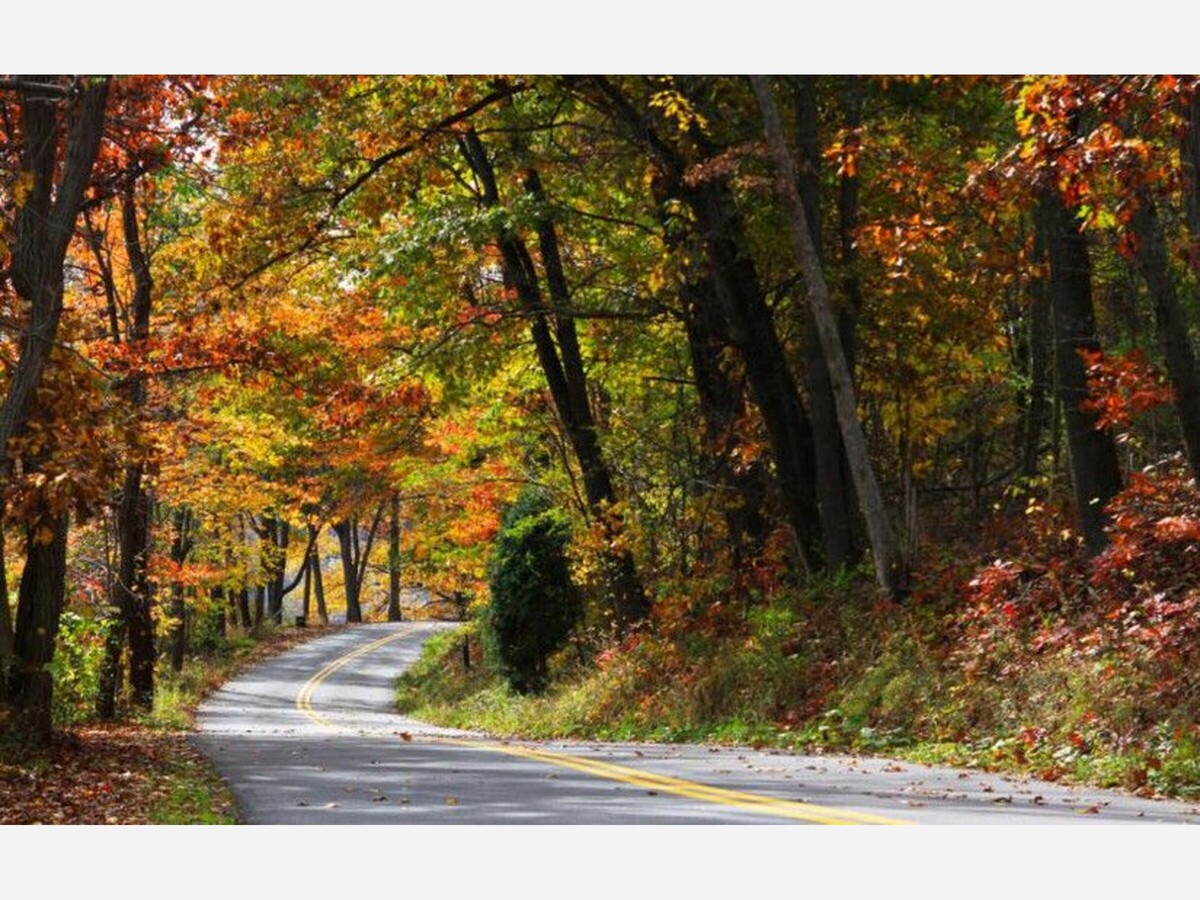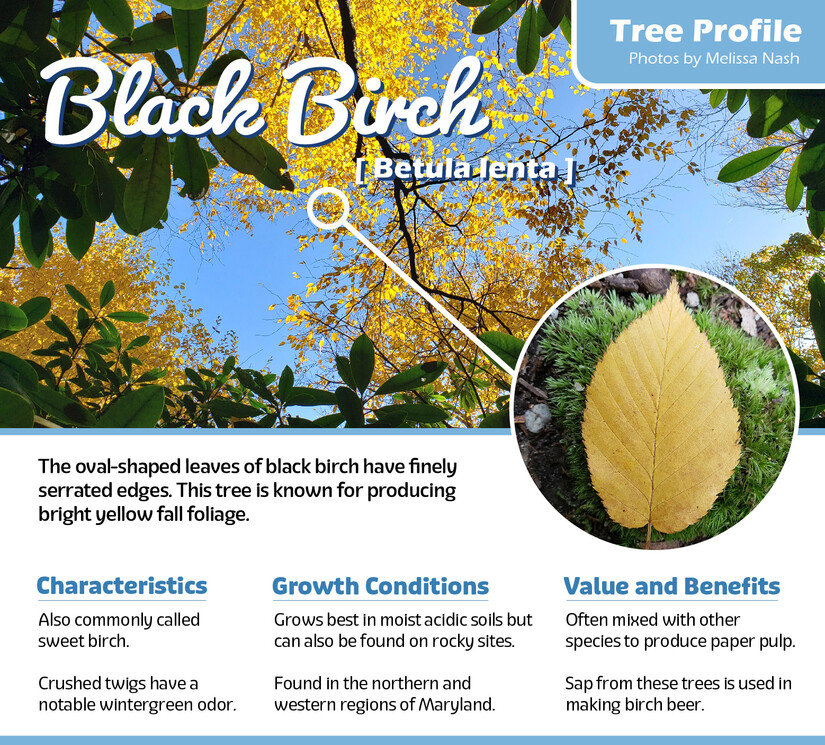Image



American beech, yellow birch, witch hazel and sugar maple leaves cover the streambed of Lostland Run in Potomac State Forest. Photo by Scott Campbell.
Trees in the Annapolis area are hesitating to show their colors this year, the result of a stressful drought-filled summer. Leaves are changing from green to yellow and brown, absent are the oranges and reds.
“It’s a slow or abbreviated fall foliage season in the Anne Arundel County area,” Natural Resources Planner and Forester Francis Smith said.
In Western Maryland, the fall foliage change has hit a subdued mid-point. Leaves are beginning to fall – make sure to leave the leaves so they can provide habitat for birds, insects, reptiles, turtles and frogs.
“Although not as widely vibrant as some years, sugar maples are still stealing the show with golden and orange tones,” said Melissa Nash, Garrett and Allegany Project Manager for the Maryland Forest Service. “Bright colors were visible along Meadow Mountain and New Germany Road this week in the area surrounding New Germany State Park and also along I-68.”
There is only minimal color change on the Eastern Shore near Assateague Island. Some dogwoods, sweetgums and maples have started to change.
Looking for something to do this weekend? Check out our Recreational Spotlight at the end of this report.
Melissa Nash, Garrett and Allegany Project Manager for the Maryland Forest Service

This image shows New Germany Road facing north on Sept. 23. Photo by Melissa Nash.
We are at the midpoint, especially in the northern end of the county. Although not as widely vibrant as some years, sugar maples are still stealing the show with golden and orange tones. Bright colors were visible along Meadow Mountain and New Germany Road this week in the area surrounding New Germany State Park and also along I-68.
Leaves are beginning to fall! If you can leave the leaves as they are beneficial in a variety of ways! Leaves act as natural mulch to help retain much needed soil moisture. As they break down, they add organic matter to the soil and act as a fertilizer. Fallen leaves also provide habitat for birds, insects, reptiles, turtles and frogs. If you can’t leave your leaves as they fall, consider collecting leaves into a mulch bed to provide these benefits!

A view of the Youghiogheny River. Photo by Melissa Nash.
Aaron Cook, Forester, Washington County
A common catchphrase during the fall foliage season is “what a difference a week can make.” Here in Washington County this week, the big difference is the weather. I have had difficulty seeing our ridges because of pervasive low cloud cover and rain. This rain and some wind brought down some of the leaves that had changed color, refreshing the viewshed back to a more green state. That said, fall changes are still visible.
The ash tree at my office here at Indian Springs Wildlife Management Area was fairly ablaze with muted color, although the damp conditions were bringing some of this color to the ground. Ash is less common on our landscape thanks to an introduced pest, emerald ash borer. But seeing this tree reminds me of how spectacular the remaining ash fall foliage can be, and how fragile our forest communities are at times.

An ash tree. Photo by Aaron Cook.
Aldo Leopold once wrote, “our ability to perceive quality in nature begins, as in art, with the pretty.” This quote makes me think of the allure of fall foliage. Most are drawn in by the vibrant maples and glowing hickories..the pretty.
|
While we wait for these trees to put on their show in Washington County, I included some pictures of vines, particularly poison-ivy and Virginia creeper, which add to the early fall color splendor, but are often unwanted or underappreciated. Virginia creeper puts on a wonderful show in the fall, and its berries help many species of birds through the cold winter months. In the case of my picture, it makes this otherwise mundane telephone pole a fall star with its burgundy and red hues. Unlike humans, many animals do not have adverse reactions to poison-ivy, and many species of migrating songbirds rely on poison-ivy berries as a preferred food to help power their incredible migrations across the Americas. Avoiding poison-ivy gets easier in the fall because its leaves turn brilliant shades of red, orange, and yellow, while its berries turn white. Common around the edges of open fields, woodlots, and trails, this is a great time of year to safely identify and observe the wonderful color of this plant, while also appreciating all of the fall flowers that frequent these same areas (and remain a very nice addition to our early fall foliage show, this week). The soaking rains are much appreciated in our region of Maryland, and soon enough warm sunny days, and cool crisp nights will return to spur on the mid-point of fall color (likely in the next 2 weeks), causing us to say “What a difference a week can make. |

A photo of virginia creeper. |
Kendra Bree, Park Ranger at Fort Frederick State Park Complex
We’re starting to see some color changes into reds, yellows, and browns, but we’re also experiencing a lot of leaf droppage, especially in our campground. We’re hoping that the rain we received these past few days helps offset the stress from this summer’s drought.
Bob Schwartz, Watershed Forester, Washington and Frederick Counties
While last week was full of the species whose early changing leaves mark the beginning of fall color, the rain this week has caused most of that foliage to drop. However, plenty of color remains if one stops to look.
Woodland sunflower, one of our later flowering native sunflowers, is blooming or just past bloom in Washington County. The sunflower genus, Helianthus, as a whole is a keystone species group in our region. Sunflower pollen may be a key component of lessened parasites in bees while goldfinches, among other birds, eagerly devour its seeds later in the season.

A woodland sunflower. Photo by Bob Schwartz.
One of the few blue colored flowers in our flora, Great Blue Lobelia, certainly lives up to its name. This short-lived, but prolifically flowering and seeding perennial is a native bee magnet that “paints” the bees’ backs with pollen when they land upon its petaled landing pad.

Great blue lobelia. Photo by Bob Schwartz.
Another woods edge wildflower in bloom, the Brown Eyed Susan, is a relative of Maryland’s state flower, the Black Eyed Susan. This taller cousin is a cheery companion on gray fall days.

A brown-eyed susan. Photo by Bob Schwartz.
Francis Smith, Natural Resources Planner and Forester
It’s a slow or abbreviated fall foliage season in the Anne Arundel County area. Some black gum trees have scattered red fall color in the forest canopy. Same can be said for our flowering dogwood here, with lighter shades of red just starting to appear on leaves in the last week or so. Otherwise, not many colorful canopies are out there at this point, which is to be expected with the stressful growing season our tree friends have endured.
Lesley Leader, Park Ranger at Fair Hill Natural Resource Management Area and Bohemia River State Park, Cecil County
Our region is still mostly green, with a little color showing in the maples and black gum leaves. Marsh and meadow grasses are turning golden, and sycamores and walnuts are dropping their leaves.

A black gum tree in Bohemia River State Park. Photo by Lesley Leader.
Meghan Rhode, Assistant Park Manager Assateague State Park, Worcester County
At Assateague we are seeing minimal color change, the color we are seeing is from the dogwoods, sweetgums and maples.

In Southern Maryland, the Monarchs and Milkweed Festival at Merkle Natural Resource Management Area takes place from 10 a.m. to 2 p.m. Saturday, Sept. 28. This family and pet-friendly event celebrates the annual migration of monarchs through our state, as well as the native plants that support their stay.
In Garrett County, Sang Run State Park volunteers host Fall Fest from 11 a.m. to 3 p.m. on Sept. 28. This delicious food from our gardens, and warm drinks for purchase. Guests can help make apple butter over the fire and press apples for fresh cider! Crafts will feature some of Sang Run’s fall favorites! Hay rides touring the property will also be avaiable.
Other Upcoming Events:
